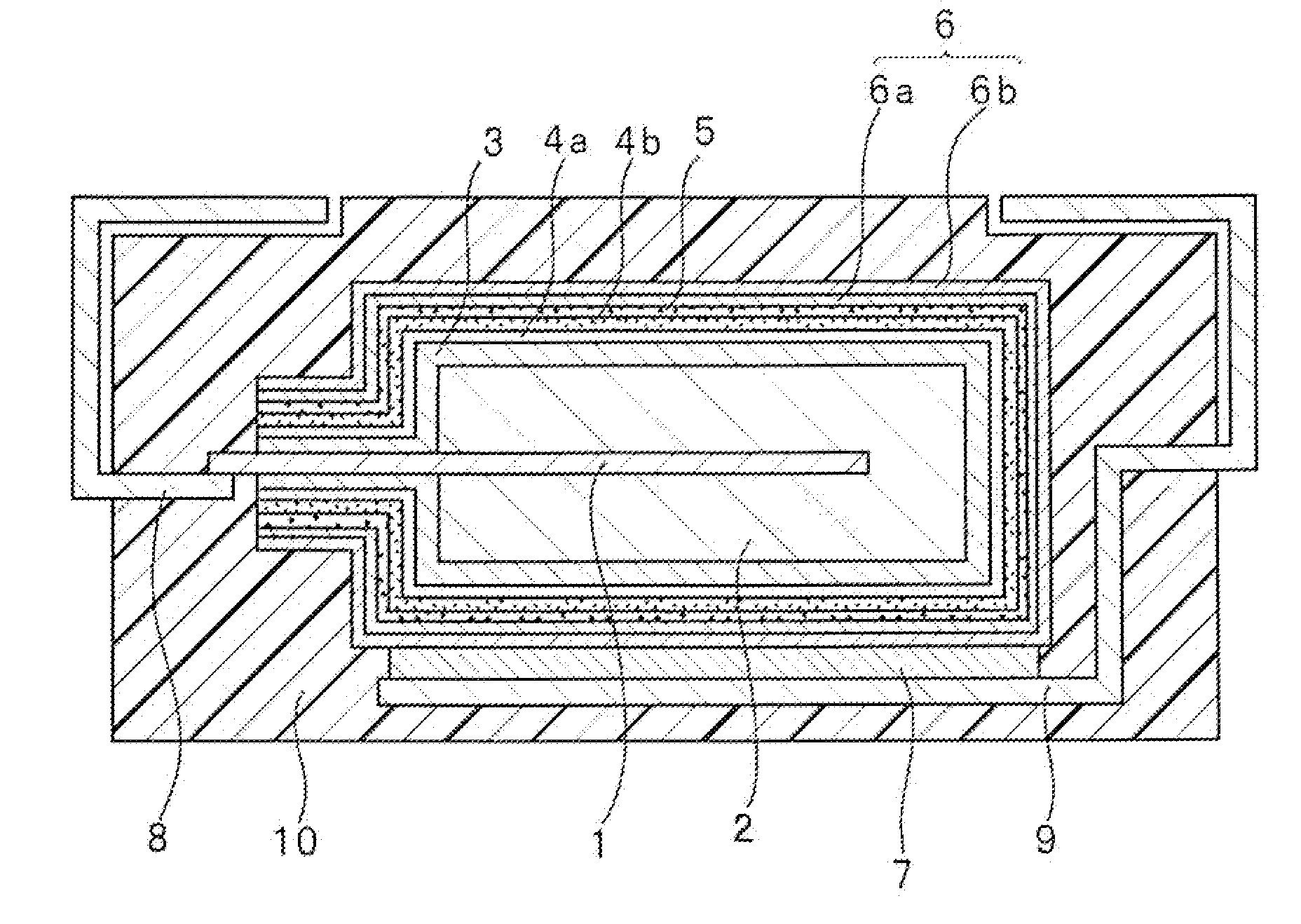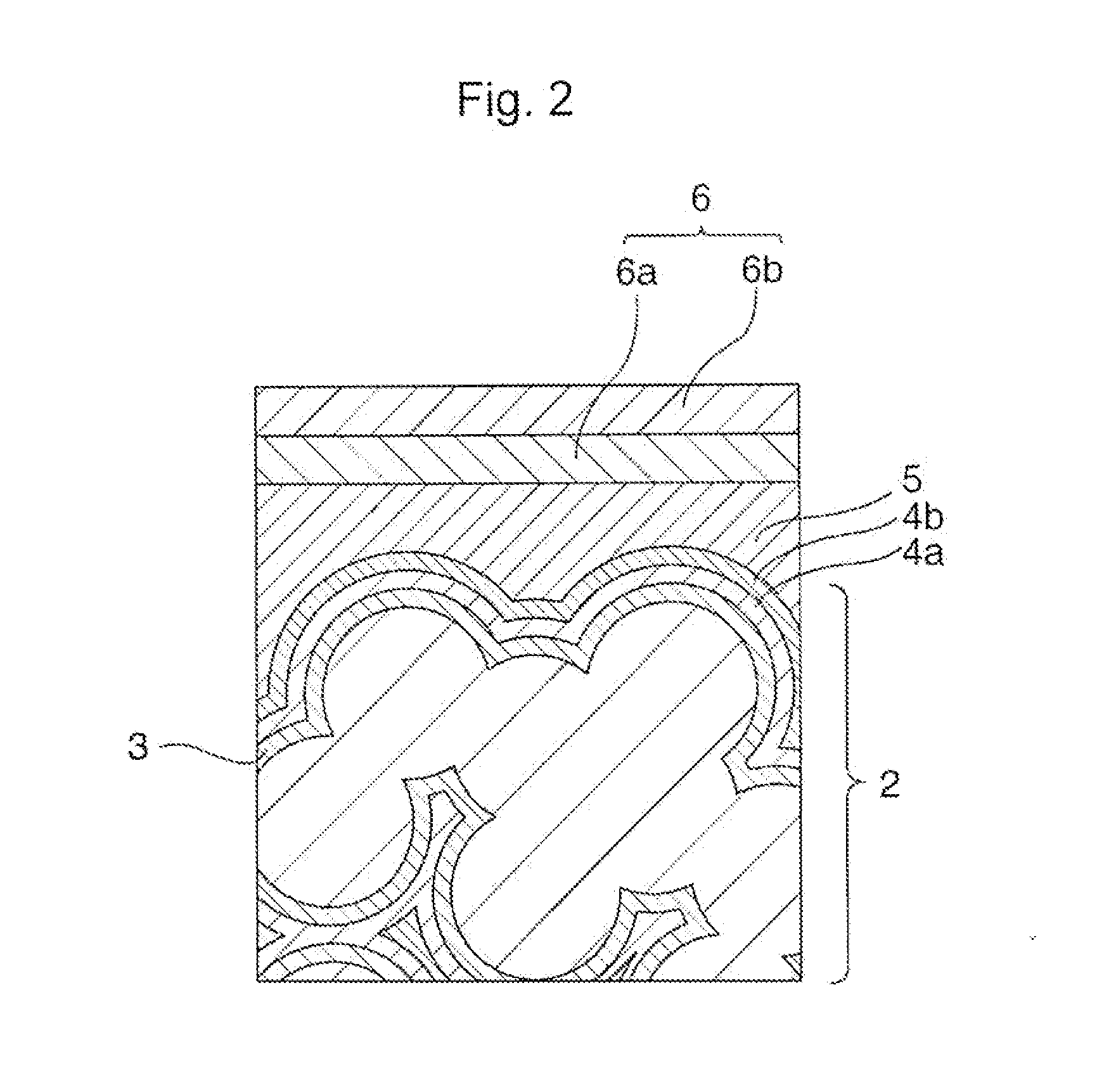Solid electrolyte capacitor
a solid electrolyte capacitor and electrolyte technology, applied in the manufacture of electrolytic capacitors, capacitor details, etc., can solve the problems of requiring capacitors, laptop computers and mobile electronic devices are strongly expected to consume less power to operate with their batteries, and drop voltage, so as to reduce leakage current, increase reliability under high-temperature and load conditions, and increase work function
- Summary
- Abstract
- Description
- Claims
- Application Information
AI Technical Summary
Benefits of technology
Problems solved by technology
Method used
Image
Examples
example 1
Step 1
[0063]Metal powder of tantalum is used as the powder of the valve metal. The tantalum powder is formed into a shape while an anode lead made of tantalum is buried in the tantalum powder. Then, the structure thus formed is sintered at approximately 1200° C. in a vacuum atmosphere, and a tantalum sintered-body element to be used as an anode body is thus obtained.
[0064]The surfaces of the tantalum sintered-body element are anodized in a phosphoric acid aqueous solution of 0.05 wt % at a constant voltage of 10 V, and thus a dielectric layer is formed.
Step 2
[0065]Subsequently, the resultant element is dipped in a solution prepared by dissolving polyvinyl alcohol (PVA) in pure water in such a manner that the solution has a PVA concentration of 0.1 wt %. Then, the element is dried to sufficiently remove the solvent, and a first polymer film is thus formed. The work function of the polyvinyl alcohol is measured with a photoelectronic spectrometer, and a value of 6.2 eV is obtained. Th...
example 2
[0071]A solid electrolyte capacitor of Example 2 is fabricated in the same manner as that of Example 1 but with a modification of Step 3 of Example 1 as follows. The element is dipped in a solution prepared by dissolving 9,9-octylfluorene-stilbene-triphenylamine copolymer in toluene in such a manner that the solution has a 9,9-octylfluorene-stilbene-triphenylamine copolymer concentration of 0.1 wt %. Then, the element is dried to sufficiently remove the solvent, and a second polymer film is thus formed. Subsequently, the following steps 4 to 6 are performed in a similar manner to those in Example 1. The work function of the 9,9-octylfluorene-stilbene-triphenylemine copolymer is measured with a photoelectronic spectrometer, and a value of 5.4 eV is obtained. The thickness of the film of 9,9-octylfluorene-stilbene-triphenylamine copolymer is calculated from the concentration and the porosity of the element, and a thickness of 10 nm is obtained.
example 3
[0072]A solid electrolyte capacitor of Example 3 is fabricated in the same manner as that of Example 1 but with a modification of Step 2 of Example 1 as follows. The element is dipped in a solution prepared by dissolving polyethylene glycol (PEG) in pure water in such a manner that the solution has a PEG concentration of 0.1 wt %. Then, the element is dried to sufficiently remove the solvent, and a first polymer film is thus formed. The work function of the polyethylene glycol is measured with a photoelectronic spectrometer, and a value of 6.0 eV is obtained. The thickness of the film of polyethylene glycol (PEG) is calculated from the concentration and the porosity of the element, and a thickness of 10 μm is obtained. Subsequently, the following steps 3 to 6 are performed in a similar manner to those in Example 1.
PUM
 Login to View More
Login to View More Abstract
Description
Claims
Application Information
 Login to View More
Login to View More - R&D
- Intellectual Property
- Life Sciences
- Materials
- Tech Scout
- Unparalleled Data Quality
- Higher Quality Content
- 60% Fewer Hallucinations
Browse by: Latest US Patents, China's latest patents, Technical Efficacy Thesaurus, Application Domain, Technology Topic, Popular Technical Reports.
© 2025 PatSnap. All rights reserved.Legal|Privacy policy|Modern Slavery Act Transparency Statement|Sitemap|About US| Contact US: help@patsnap.com



